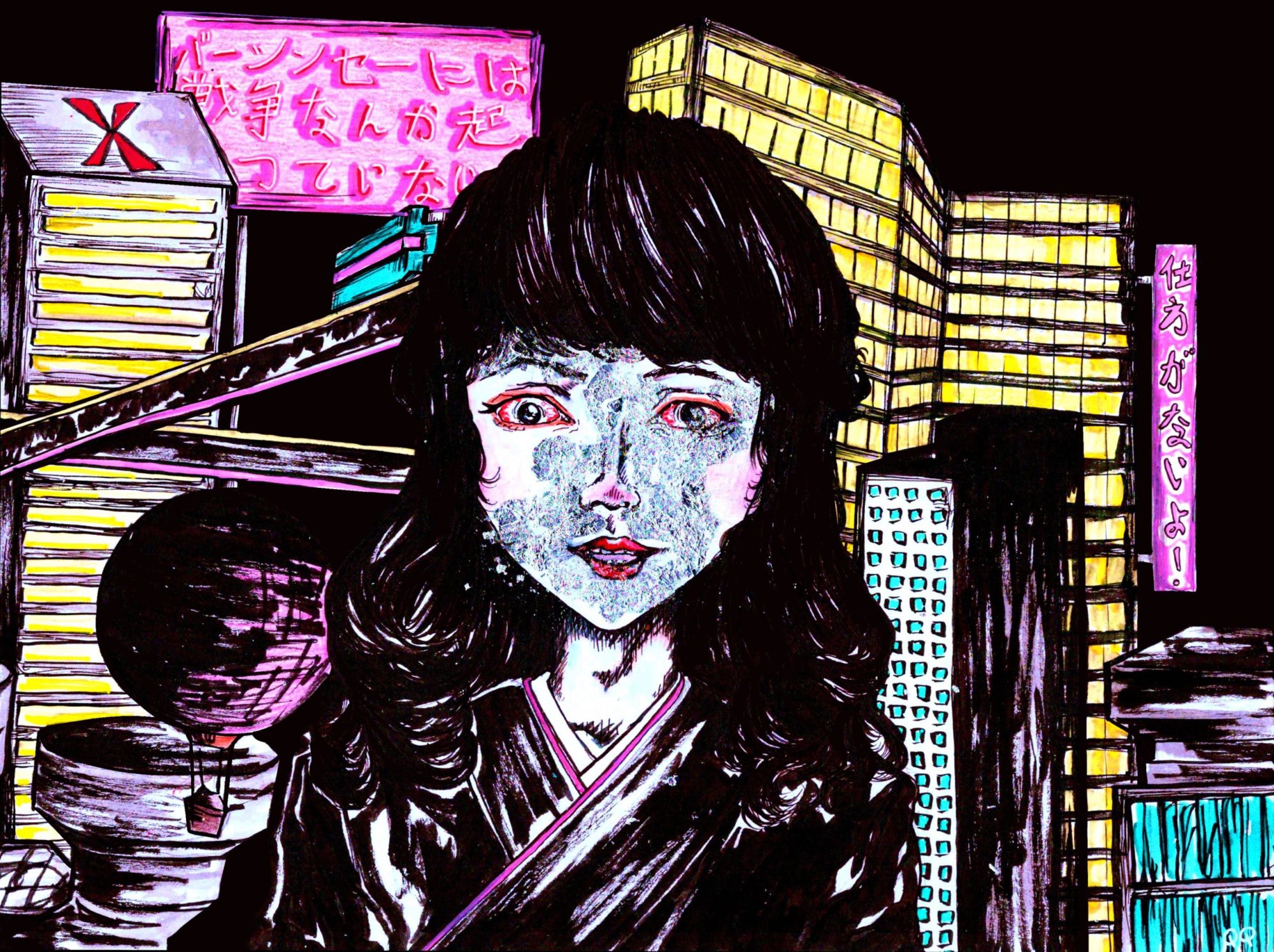The fourth installment of Inkstick Media’s new culture column, The Mixed-Up Files of Inkstick Media, explores techno-orientalism as it is expressed in media and the public and how that then affects our understanding and consumption of current events and foreign/public policy.
Unless you live under a rock, you must have heard by now that “BTS” stands for more than “behind the scenes.” Or maybe you’ve noticed your 10-year-old running around your yard, bent over at a 90-degree angle with arms stretched out straight behind them, in what’s called the “Naruto run” or more generally the “ninja run.” Remember the “fox eye” trend last year that took Instagram by storm? No doubt, the prominence of East Asian cultures and aesthetics appears to be growing in the US, but that influence seeps out into other realms of society, including foreign policy.
First off, what even is “weeaboo” or a “Koreaboo”? They’re almost like the original terms for what most now call “Asian fishing.” Weeaboo specifically refers to non-Asian people who are hyper-obsessed with Japanese anime and manga and then from that will often appropriate Japanese aesthetics or cultural practices without genuine regard for historical or cultural significance. Koreaboos are similar but for K-pop idols or groups instead. A prominent example of a Koreaboo (albeit one that takes it to new levels of extreme) is Olli London, a white British influencer who claims to be “transracial” and identifies as Korean. They have undergone multiple plastic surgeries to look more like BTS band member Jimin.
The (at best) questionable use of Asian aesthetics — including both physical features of Asian people, Asian culture, and Asian landscapes — has been around long before social media, however, particularly in sci-fi and dystopian media. Scholars David Roh, Betsy Huang, and Greta Niu coined the term “techno-orientalism,” an expansion on the term “orientalism” first coined by scholar Edward Said, to describe this type of treatment toward Asia and Asian people in media.
Although consumption of Asian-ness as a commercial product or evoked aesthetic continues to explode, the othering of Asia and its people grows with it.
One early, mainstream example of the use of Asian aesthetics to project some idea of the future can be traced as far back as “Star Wars IV: A New Hope,” from its costume design and character compositions both pulling heavily from archetypes in Asian films and culture. Darth Vader’s iconic helmet was noted by George Lucas to be inspired by the Kabuto helmet of samurai Date Masamune. All of Luke Skywalker’s mentors also resemble orientalist tropes from their robes to their “zen” demeanor which Dr. Jane Iwamura dubbed the “Oriental monk” (also seen on the big screen as recently as in “Doctor Strange”). The success of “A New Hope,” specifically, ushered in a new era of blockbuster films — a cultural phenomenon that established techno-orientalism as a style of visual representation in sci-fi that has arguably outlasted even Star Wars’ own popularity.
Recent media examples of techno-orientalist messaging or imagery include the 2014 movie “Ex Machina” in which an AI sex-robot is played by an Asian actress and named “Kyoko,” or the animated, children’s superhero movie from the same year “Big Hero 6” in which the setting is quite literally named “San Fransokyo.” And, even more recently, celebrity, musician, and former partner of Elon Musk, Grimes, posted a TikTok with a green screen background of a panel from the massively popular manga series “Berserk” despite her video having nothing to do with the manga series or even with manga and anime in general.
Though these media forms are generally thought of as pure entertainment, the subtext of plastering LED, neon lights with Japanese brand names across the dystopian-LA skyline of the 1982 film “Blade Runner” does more than just look cool. These references signal to audiences and consumers that terror is the appropriate response to the “anticipation of an overwhelming Asian future.” Even media that does not use these tropes in purely sinister ways still conflates a hyper-technological future with profuse “Asian-ness.” The added bonus of the high-tech sci-fi worlds also being complete dystopias with Japanese AI robots incapable of true humanity or higher level situational awareness sends a clear message, even if subliminal: “East Asians are imagined as hyper-technological but intellectually primitive,” aptly put by TikTok user @haileyych.
It feels like a back-to-back play of UNO reverse cards. Instead of being primitive savages like in the good ole days of European colonialism, Asia is now too advanced, except only in terms of our tech but not in terms of our minds. “Primitive” is as “primitive” does. The hypocrisy in orientalism of who bears the right to own certain technologies such as nuclear weapons or expansive surveillance networks is further supported by the subtext (if not the overt text) of techno-orientalist narratives.
We’ve increasingly watched the violent and lethal consequences of dehumanizing tropes within techno-orientalism unfold from the murder of Vincent Chin in 1982 to the 150% increase in incidents of anti-Asian violence reported by California State University in the US’s 16 largest cities for 2020. These incidents include the shootings in Atlanta that killed 6 Asian women, the murder of 84-year-old Thai grandfather Vichar Ratanapakdee, the stabbing of two toddlers and their father in a grocery store, and an Asian woman splashed with acid while taking out her trash, with plenty more left unmentioned here.
On a foreign policy level, techno-orientalism warps others’ understanding of China and East Asia broadly by the rumors that Chinese people are intelligent enough to have manufactured the entire pandemic from a lab in Wuhan, yet are so incapable of critical thought that they couldn’t possibly support the Chinese Communist Party without being brainwashed. This cognitive dissonance in trying to understand China, its people, its government, and culture as we consume news and media about them becomes ever more relevant as President Joe Biden readies for a new Nuclear Posture Review, headlines proliferate on Chinese nuclear weapons expansion, and tensions come ever closer to a breaking point in the South China Sea.
So, although consumption of Asian-ness as a commercial product or evoked aesthetic continues to explode, the othering of Asia and its people grows with it. From such popular films like “Star Wars” and “Big Hero 6” or from the export of anime and K-pop idols, East Asia is commodified and appropriated by the white West to the point that rising Cold War tensions with China may make the very existence of the country entirely expendable because white people can just layer on enough filters on TikTok or Instagram to carry on our aesthetics.
That is to say, in some hypothetical universe in which China or East Asia broadly is “exterminated” — whether in a literal sense through a nuclear war or a metaphorical sense through assimilation — it doesn’t necessarily matter because “weeaboos” and “Koreaboos” will carry on the “traditions” of their fetishized interpretations of our appearances and culture. The West will extract commercial use from Asian bodies and labor via anime, manga, and K-pop while refusing to finally declare an official end to the Korean War after more than 70 years. To consume and enjoy anime or K-pop is not in and of itself problematic. But these works also come from entire countries full of entire populations with their own separate histories and cultures far richer and diverse then a single media form could possibly cover.





















